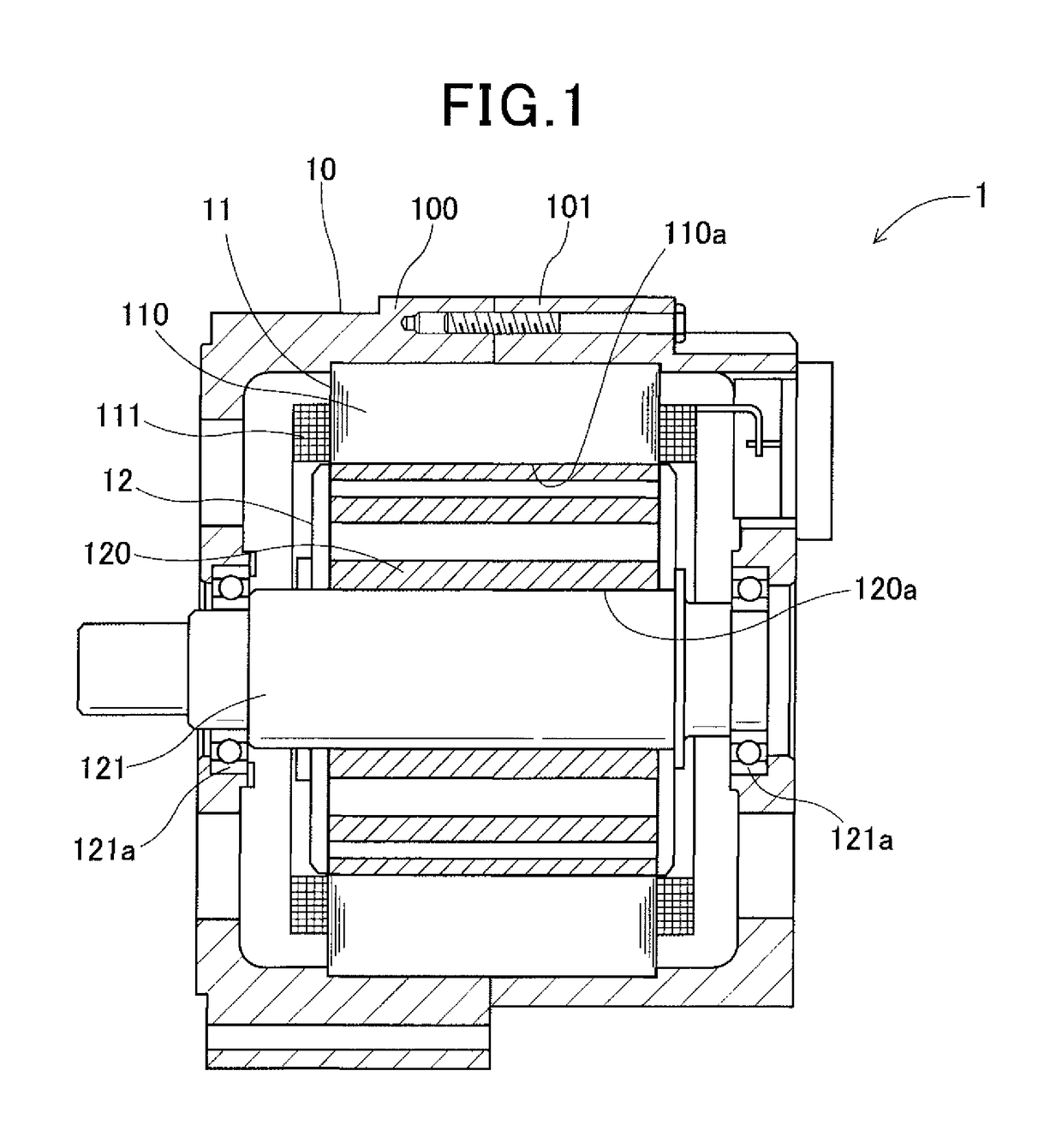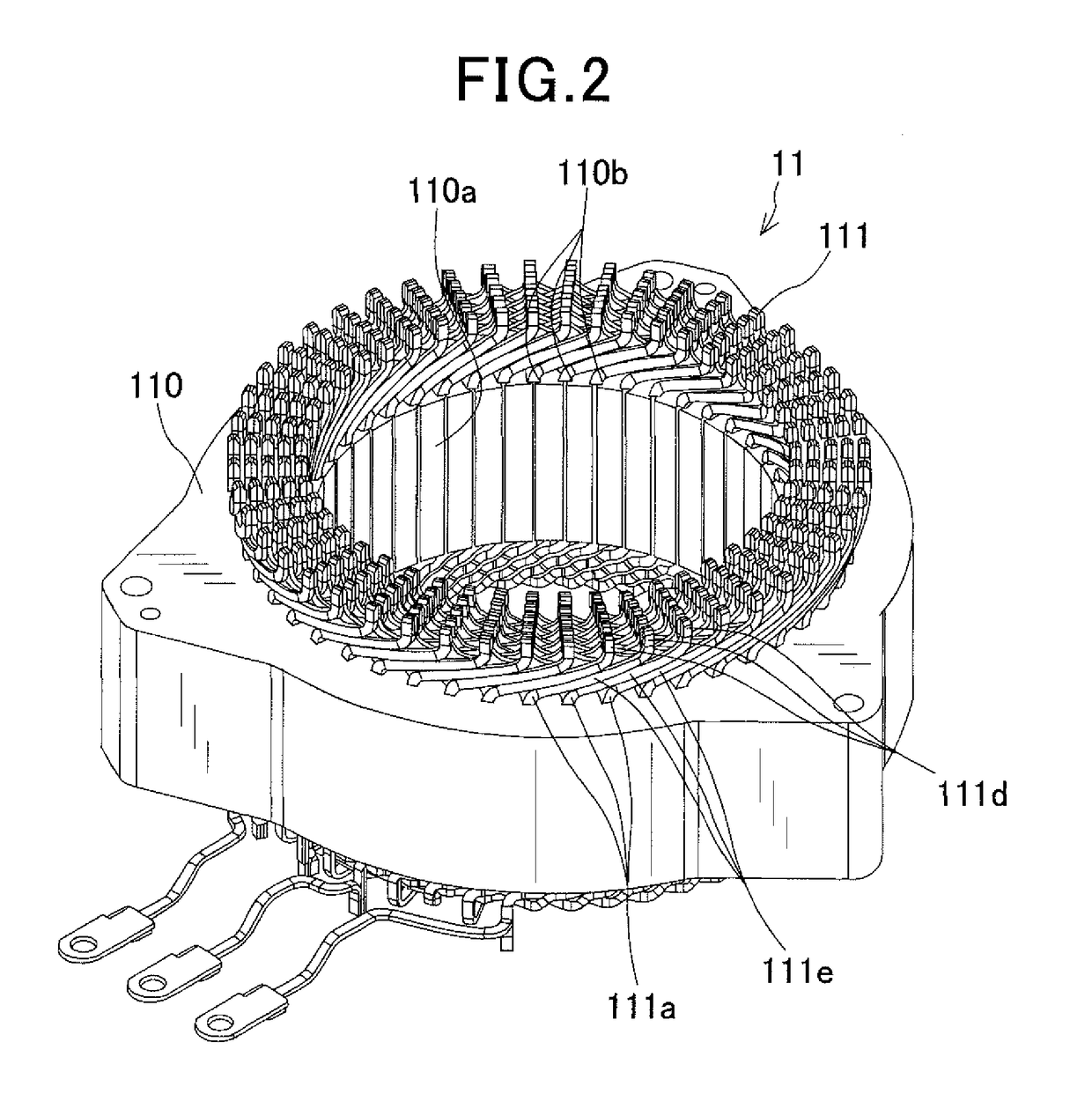Rotating electric machine and method of manufacturing same
a technology of rotating electric machines and rotating plates, which is applied in the direction of dynamo-electric machines, electrical apparatus, magnetic circuits, etc., can solve the problems of uneven surface of welds, peeling of weld-insulating parts, and uneven joint formation of uneven parts on the surface of welds, so as to enhance the adhesion force of weld-insulating parts and reduce the mechanical strength of welds. , the effect of forming the uneven
- Summary
- Abstract
- Description
- Claims
- Application Information
AI Technical Summary
Benefits of technology
Problems solved by technology
Method used
Image
Examples
first embodiment
[0051]FIG. 1 shows the overall configuration of a rotating electric machine 1 according to a first embodiment.
[0052]In the present embodiment, the rotating electric machine 1 is configured as a motor-generator for use in a motor vehicle. Specifically, upon being supplied with electric power from a battery (not shown) of the vehicle, the rotating electric machine 1 functions as an electric motor to generate torque (or driving force) for driving the motor vehicle. Otherwise, upon being supplied with torque from an engine (not shown) of the vehicle, the rotating electric machine 1 functions as an electric generator to generate electric power for charging the battery.
[0053]As shown in FIG. 1, the rotating electric machine 1 includes a housing 10, a stator 11 and a rotor 12.
[0054]The housing 10 receives both the stator 11 and the rotor 12 therein and rotatably supports the rotor 12. The housing 10 is comprised of a pair of cup-shaped housing pieces 100 and 101 which are jointed together ...
second embodiment
[0081]A rotating electric machine 1 according to a second embodiment has almost the same structure as the rotating electric machine 1 according to the first embodiment. Accordingly, only the differences therebetween will be described hereinafter.
[0082]In the first embodiment, the uneven portions of the welds are formed by pressing the die M against the surfaces of the welds. In comparison, in the present embodiment, the uneven portions of the welds are formed by cutting the surfaces of the welds.
[0083]Specifically, in the present embodiment, as shown in FIG. 10, each of the welds 211b is formed by welding end portions of one pair of the electric conductors 211d of the electric conductor segments 211a. Moreover, each of the welds 211b has the uneven portion 211g formed on the surface thereof.
[0084]As shown in FIG. 12, the uneven portion 211g is formed by cutting at least part of the surface of the weld 211b with a cutting tool CT while rotating the weld 211b.
[0085]More specifically,...
third embodiment
[0089]A rotating electric machine 1 according to a third embodiment has almost the same structure as the rotating electric machine 1 according to the first embodiment. Accordingly, only the differences therebetween will be described hereinafter.
[0090]In the first embodiment, the uneven portions of the welds are formed by pressing the die M against the surfaces of the welds. In comparison, in the present embodiment, each of the electric conductors of the electric conductor segments is constituted of a plurality of electric conductor wires; the uneven portions of the welds are formed by a shield gas flow and a magnetic field created during the welding of end portions of the electric conductors.
[0091]Specifically, in the present embodiment, as shown in FIGS. 13 and 14, each of the electric conductor segments 311a includes an electric conductor 311d and a conductor-insulating member 311e. The electric conductor 311d is constituted of a plurality of electric conductor wires 311h having a...
PUM
 Login to view more
Login to view more Abstract
Description
Claims
Application Information
 Login to view more
Login to view more - R&D Engineer
- R&D Manager
- IP Professional
- Industry Leading Data Capabilities
- Powerful AI technology
- Patent DNA Extraction
Browse by: Latest US Patents, China's latest patents, Technical Efficacy Thesaurus, Application Domain, Technology Topic.
© 2024 PatSnap. All rights reserved.Legal|Privacy policy|Modern Slavery Act Transparency Statement|Sitemap



